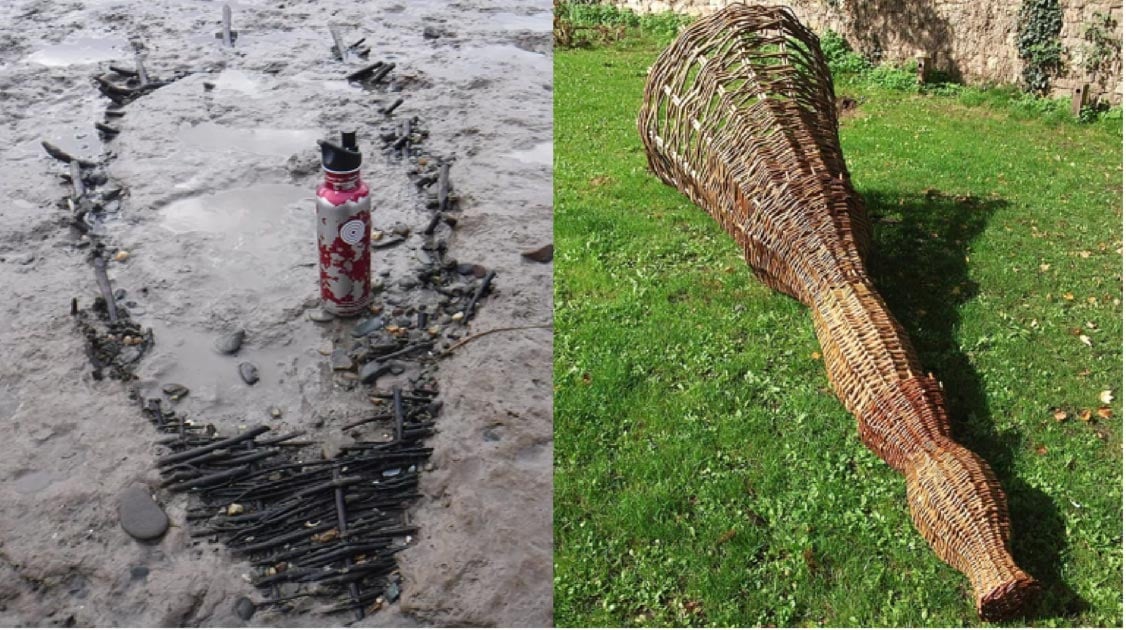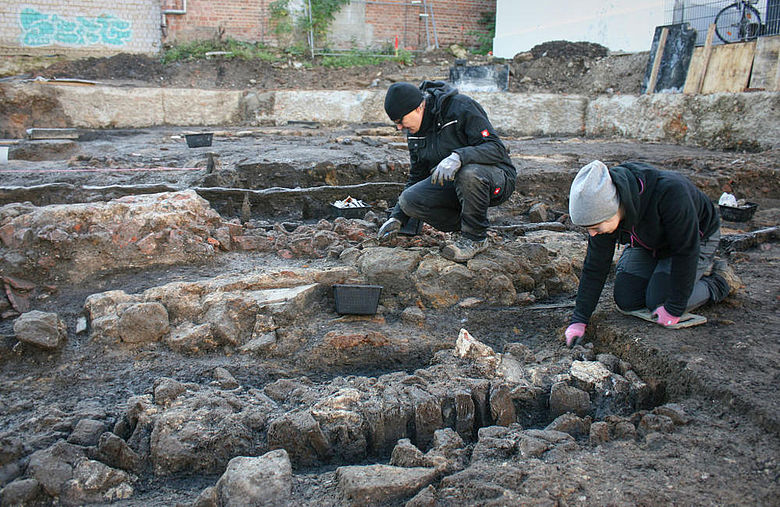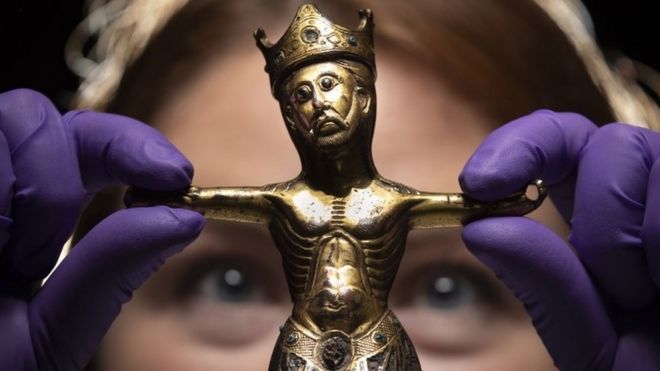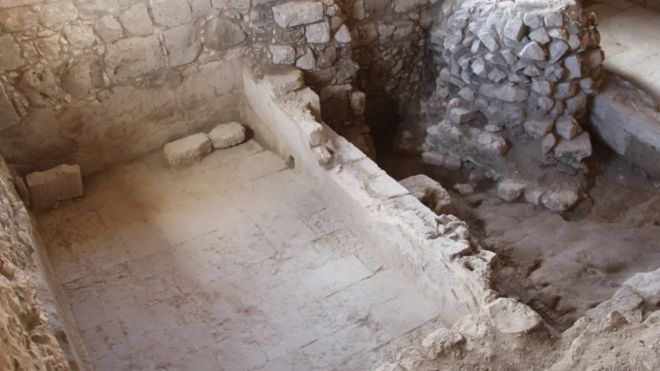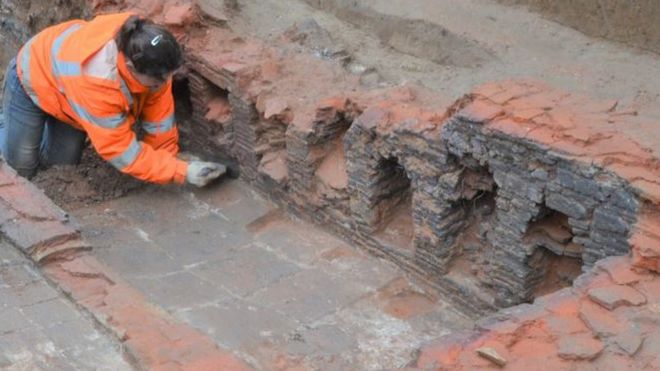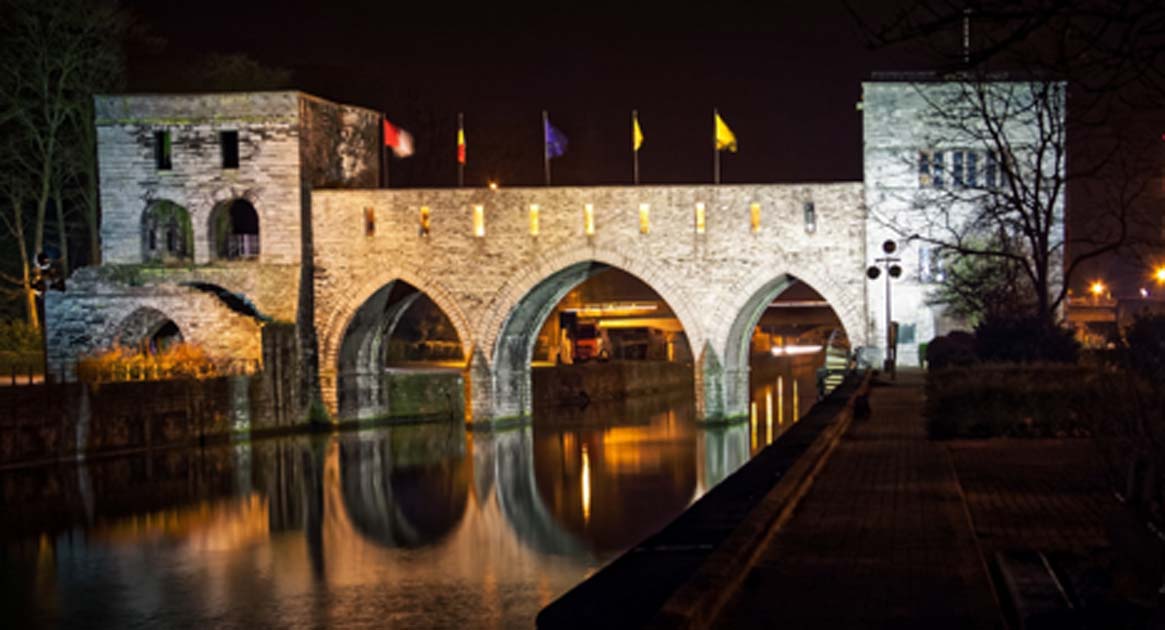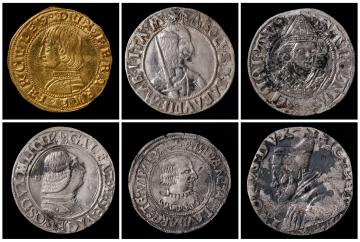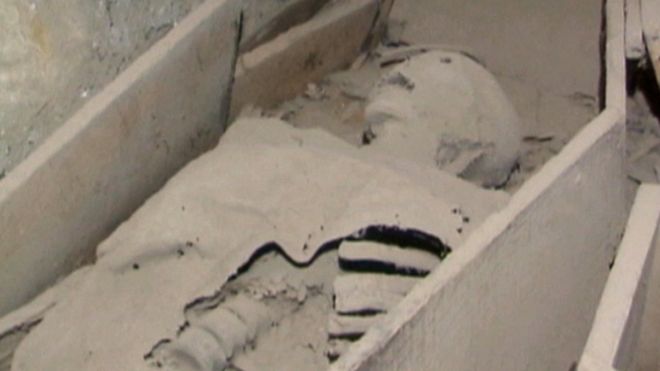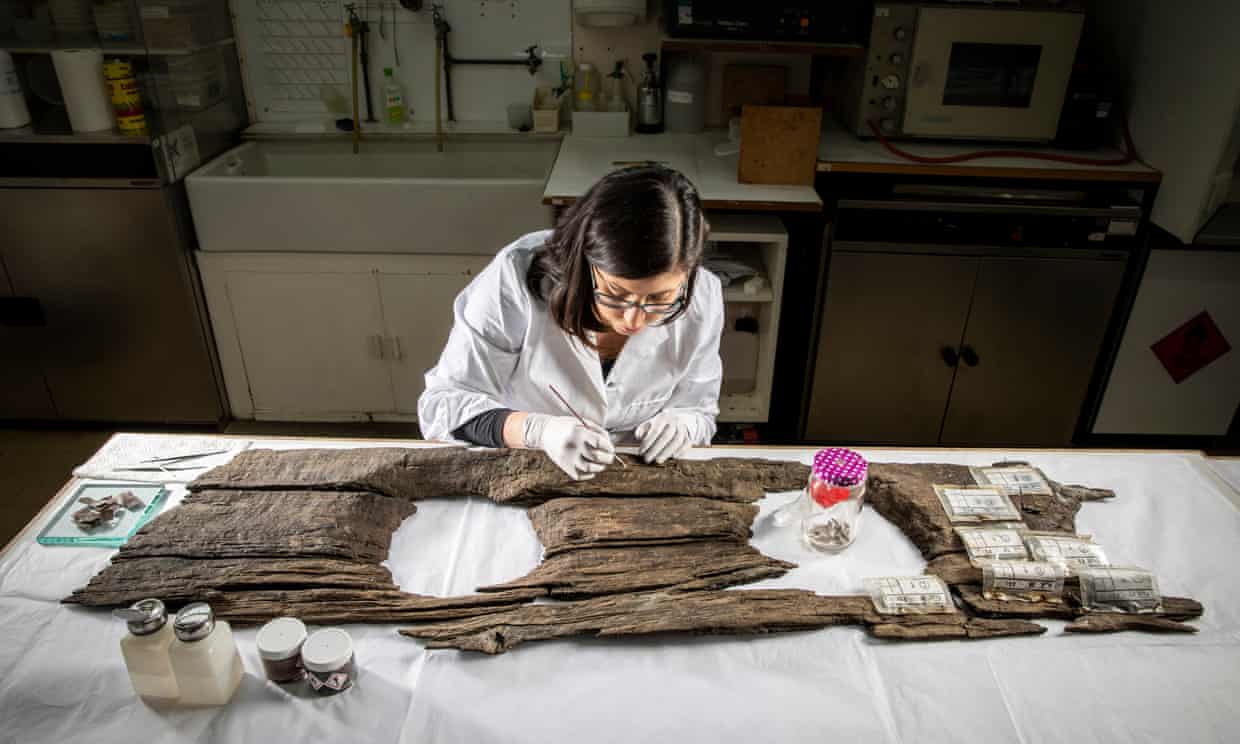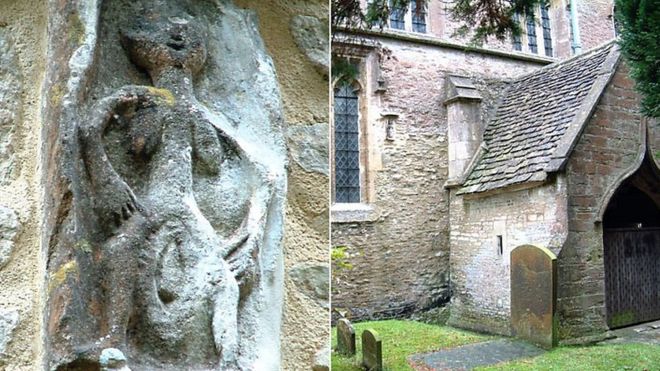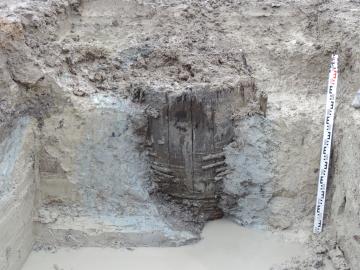Archaeological news about the Archaeology of Later Medieval Europe from the Archaeology in Europe web site
Saturday, 21 December 2019
Catch of the Day! Medieval Fishing Basket Found in the Severn
Traditional fishermen have made a unique discovery, they have found a medieval fishing basket that is up to 700-years-old stuck in some silt, in a British estuary. It has been preserved in the clay of the Severn Estuary in the south-west of England. This basket is possibly the largest of its kind found from the Middle Ages in the area.
The Severn Estuary is the estuary of the largest river in England and three other major rivers also flow into this body of water. The estuary has long been a rich source of fish and eels for local people. A collective of Welsh fishermen, known as the Black Rock Lave Native Fishermen group, still fishes in the body of water using traditional methods. The Daily Mail , states that they utilize “traditional wooden lave frames to catch fish,” which is a method that has been handed down through the generations. The group is committed to protecting “the heritage and tradition of Lave Net fishing in Wales,” according to the Black Rock Lave Native Fishermen website.
Read the rest of this article...
Medieval Danish Queen's cellar is one of 2019’s top ten archaeological finds
Photo: Slots- og Kulturstyrelsen
The discovery of a cellar in Roskilde believed to have belonged to medieval Danish Queen Margrete I is one of this year's ten most important archaeological finds.
Among other important Danish discoveries this year are an approximately 3,000-year-old sacrificial victim in Thy, a mysterious amber sun disc of amber near Viborg and a Bronze Age burial mound with a crematorium at Bellinge near Odense.
The list was published by the Ministry of Culture’s Agency for Culture and Palaces in a press release.
In Roskilde, medieval archaeologist Jesper Langkilde said he is proud that the cellar is on the annual list.
“It is not commonplace to find such well-preserved ruins from the Middle Ages, and when we can also ascertain that it is very likely that the cellar belonged to Margrete I, that in my brings the discovery into a class of its own,” Langkilde said.
Thursday, 19 December 2019
UNE OCCUPATION RURALE ATYPIQUE EN PÉRIPHÉRIE DE LA SOUTERRAINE
Une équipe d’archéologues de l’Inrap mène actuellement une fouille sur la commune de La Souterraine, au lieu-dit La Petite Prade. Les archéologues mettent au jour une occupation rurale médiévale (IXe – XIIIe siècles) constituée – notamment – d’un ensemble de bâtiments et de souterrains. Prescrite par l’État (Drac Nouvelle-Aquitaine), la fouille est réalisée en amont d’un aménagement d’environ 2 hectares sur une zone d’activité commerciale.
DES SOUTERRAINS MÉDIÉVAUX DIFFICILES À CARACTÉRISER
L’exploration de deux souterrains aux ramifications complexes permet aux archéologues de l’Inrap de documenter précisément ce type de constructions qui restent encore mal connues. Les fouilles commencent à livrer les premiers éléments de leur mise en œuvre : les galeries sont creusées dans un sous-sol meuble d'altérites (roches altérées) jusqu’à 2,60 mètres de profondeur. Leurs tracés, en cours d’identification, serpentent pour l’instant sur une surface d’environ 400 m². Les galeries, larges d’environ un mètre, semblent avoir été consolidées à l’aide d’éléments en bois.
Read the rest of this article...
Sunday, 8 December 2019
Archaeological Study Tour to Orkney
EMAS Study Tour to Orkney
14 – 23 April 2020
There are still a few places left on the EMAS Archaeological Society Study Tour to Orkney.However, hotel places are very limited, so an early reply is advised.
You can find further details on the EMAS website.
Further details...
Monday, 11 November 2019
Mittelalterliche Häuser und Kanäle
Mit Kellen legen die Archäologen Mauern aus Bruch- und Backstein frei.
Foto: Archäologie am Hellweg eG/U. Holtfester
Schon in einer Tiefe von einem Meter stießen die Archäologinnen auf Spuren von städtischen Häusern aus dem 13. Jahrhundert. Senkrecht im Boden steckten zahlreiche Pfosten und Staken. Diese Hölzer bildeten Unterbauten für verschiedene Nebengebäude wie Schuppen und Kleintierställe. Erst so war es überhaupt möglich, auf dem hier sehr feuchten Boden Häuser zu errichten.
"Für die Menschen im Mittelalter bedeutete der feuchte Untergrund einen erhöhten Aufwand", erklärt LWL-Archäologe Dr. Sven Spiong, der die Ausgrabung betreut. "Für uns Wissenschaftler ist er dagegen ein Glücksfall, da in dauerhaft feuchtem Milieu organische Materialien wie Holz über sehr lange Zeiträume erhalten bleiben."
Auf der 1.200 Quadratmeter großen Grabungsfläche fanden die Archäologinnen außerdem die Überreste von Kanälen. Einst leiteten diese Kanäle die Abwässer und das Regenwasser von den ehemaligen Wohnhäusern an der Straße in die hinteren Grundstücksbereiche. Sie belegen damit indirekt die Standorte der nicht mehr erhaltenen mittelalterlichen Wohnhäuser. Die Spuren der Wohnhäuser fehlen, da sie zur heutigen Straße hin standen, wo in der Neuzeit Keller angelegt wurden.
Read the rest of this article...
Thursday, 17 October 2019
Skeletons of six babies found during archaeological dig
House of the dead: scientists examine the remains of one of the children.
Muzeum im. ks. Stanisława Staszica w Hrubieszowie/Facebook
Archaeologists have found the skeletons of six babies in a medieval “house of the dead” near Poland’s border with Ukraine.
In 2017, famers started noticing bones appearing in their fields in the village Gródek nad Bugiem, so they swiftly informed the nearby Hrubieszów Museum about the grisly findings. Rightfully so as the bones led to astonishing discoveries - burials from 11th century, the times of Bolesław I the Brave and his famous battle with Yaroslav the Wise, Grand Prince of Rus, which took place somewhere nearby.
Excavation work on the site was led by Dr Tomasz Dzieńkowski from the Maria Curie-Skłodowska University’s Institute of Archaeology and has covered a site about 300 meters from a medieval stronghold.
Read the rest of this article...
Thursday, 10 October 2019
Lost Kirkwall Cathedral Buildings Found During Roadworks in Orkney
Part of the wall of the sub deans manse looking towards
St Magnus Cathedral, Kirkwall, Orkney
A team from ORCA Archaeology discovered sections of wall that were part of the St Magnus Cathedral Close last week while undertaking a watching brief for an Orkney Islands Council infrastructure project in the heart of historic Kirkwall.
A series of walls, pottery and animal bones were unearthed only inches under the surface of the road near the entrance to Victoria Street. Archaeologists know from previous work that remains of structures dating back to the Iron Age exist in this area, but this is the first time that structures directly relating to the cathedral precinct have been identified in this particular area.
Read the rest of this article...
Lost Kirkwall Cathedral Buildings Found During Roadworks in Orkney
Part of the wall of the sub deans manse looking towards
St Magnus Cathedral, Kirkwall, Orkney
A team from ORCA Archaeology discovered sections of wall that were part of the St Magnus Cathedral Close last week while undertaking a watching brief for an Orkney Islands Council infrastructure project in the heart of historic Kirkwall.
A series of walls, pottery and animal bones were unearthed only inches under the surface of the road near the entrance to Victoria Street. Archaeologists know from previous work that remains of structures dating back to the Iron Age exist in this area, but this is the first time that structures directly relating to the cathedral precinct have been identified in this particular area.
Read the rest of this article...
Wednesday, 25 September 2019
Rare 800-year-old figure of Christ returned to York
The statue is embellished with stone settings on the crown, eyes and loincloth
PA MEDIA
An 800-year-old figure of Christ that once adorned St Mary's Abbey in York will be returned to the city after nearly two centuries.
The rare object, made in Limoges, France, in the 13th Century, was found in 1826 in the ruins of the abbey.
It disappeared for 100 years before it became part of a private German art collection in the 1920s.
It was bought by York Museums Trust and will be displayed at the Yorkshire Museum, on the site of the old abbey.
The 16cm figure would have been mounted on an enamelled cross and decorated a religious object, such as a manuscript cover or a casket.
Read the rest of this article...
Wednesday, 14 August 2019
Crusader winery found under house in Israel
The winery is unusual in having two treading floors
RABEI KHAMISY
A huge winery dating back to the Crusades has been found under a house in Mi'ilya in northern Israel.
The townspeople have been working together to shore up the ruins of the 12th century King's Castle that dominates their Galilee skyline under the guidance of local archaeologist Rabei Khamisy, the Haaretz newspaper reports.
But a businesswoman who runs a filling station in the popular tourist destination asked for a parallel dig under her own property, and that's where Dr Khamisy uncovered what could be the largest wine factory the Crusaders ever built during their presence in the Levant.
"The Byzantines had much larger wineries, but the Crusaders had nothing comparable as far as we know," he told Haaretz.
Read the rest of this article...
Saturday, 10 August 2019
See the latest discoveries made at Auckland Castle dig site
ARCHAEOLOGICAL finds have opened a window into the lives of some of the country’s most powerful men, from the food they ate to where they went to the toilet.
Centuries ago the Prince Bishops of Durham were considered second only to the king, with the authority to raise an army and mint their own coins.
Now, students and archaeologists from Durham University have uncovered more about their lifestyle in a dig at one of their most important homes Auckland Castle, in Bishop Auckland.
Working alongside staff and volunteers from The Auckland Project charity, which owns the castle, they excavated to the north of St Peter’s Chapel, which previously served as the Castle’s Great Hall.
Fragments of 12th century Polotsk princely residence unearthed in Belarus Read full text at: https://eng.belta.by/society/view/fragments-of-12th-century-polotsk-princely-residence-unearthed-in-belarus-123220-2019/ If you use BelTA’s materials, you must credit us with a hyperlink to eng.belta.by.
USHACHI DISTRICT, 8 August (BelTA) - Archaeologists and volunteers have unearthed fragments of a countryside residence of Polotsk princes dating back to the 12th century on the shores of Lake Cherstvyaty in Ushachi District, BelTA has learned.
The archaeological expedition started three weeks ago and already found the fragments of a countryside residence of Polotsk princes dating back to the 12th century. Some time ago historian Vasily Voronin suggested a hypothesis that the lands and courtyards of the Polotsk voivode of the 16th century could be a princely legacy of the earlier periods. “We have just found evidence that there was princely ancestral property. We found an exact location but similar buildings are in other locations in this area,” said Ph.D. in History Marat Klimov, a senior researcher at the Institute of History of the National Academy of Sciences of Belarus.
Read the rest of this article...
Thursday, 8 August 2019
Medieval artefacts found under Reading housing development
The tiles kilns were unearthed at what is thought to have been a medieval tile production site
TVASS
Two tile kilns similar to the terracotta ones on the floor of Reading Abbey were among the artefacts found at the site on Silver Street in Reading.
Thames Valley Archaeological Services (TVASS) also found a nearby pit where it is believed clay was extracted for the tile factory.
It described the discovery as "rare".
Project co-ordinator Tim Dawson said the tile kilns, estimated to be from AD1250-1500, were the "stars of the site" as they indicated there used to be a tile manufacturing site linked to Reading Abbey.
Read the rest of this article...
Monday, 5 August 2019
13th Century Pont des Trous Bridge Demolished: Archaeological Vandalism or Economic Progression?
Angry Belgians and a minister of that countries federal government have voiced their distain towards politicians and counselors who ordered the dismantling of Tournai’s gothic “Bridge of Holes” so that larger boats can sail and spend on the Scheldt river.
In 1968, a sinking 19th century granite London bridge, designed by John Rennie to replace a medieval predecessor, was sold to American oil tycoon Robert P McCulloch for $2,460,000. This Londonist article explains how the landmark was dismantled and shipped over the Atlantic to Lake Havasu in Arizona, where it still stands today. In this instance it was argued that the bridge was ‘going to collapse anyway, so why not be saved an American’? But where this sort of thing goes wrong is when an ancient bridge is dismantled to increase profits and income, and this is what’s just happened in Belgium.
Built between 1281 and 1304, the Pont des Trous is one of three existing 13th-century military bridges left anywhere in the world, and it is unquestionably one of the most prestigious vestiges of the medieval military architecture in Belgium. It was part of the second wall of the city and defended the course of the Scheldt river along the town and its name comes from a local loch that was called Les Trous, or the holes.
Read the rest of this article...
Thursday, 13 June 2019
Ancient DNA from Roman and medieval grape seeds reveal ancestry of wine making
Statue of Dionysus (Bacchus), god of wine (stock image).
Credit: © Ruslan Gilmanshin / Adobe Stock
A grape variety still used in wine production in France today can be traced back 900 years to just one ancestral plant, scientists have discovered.
With the help of an extensive genetic database of modern grapevines, researchers were able to test and compare 28 archaeological seeds from French sites dating back to the Iron Age, Roman era, and medieval period.
Utilising similar ancient DNA methods used in tracing human ancestors, a team of researchers from the UK, Denmark, France, Spain, and Germany, drew genetic connections between seeds from different archaeological sites, as well as links to modern-day grape varieties.
Read the rest of this article...
Thursday, 6 June 2019
Incredibly rare ancient map of London is discovered from 1572 – and the roads are the same
The map shows little life to the south of the river, but the city is already full of winding streets (Picture: BNPS)
An extremely rare example of the earliest surviving map of London has been discovered. The 1572 city plan, by engraver Frans Hogenburg, provides a fascinating bird’s eye view of the underdeveloped capital city.
It reveals there was a large settlement north of the River Thames, but south of it was sparsely populated. T
he colourful map depicts many boats weaving their way down the river, which could only be crossed by the solitary Old London Bridge.
Recognisable landmarks include the Tower of London, the Charterhouse monastery and the old St Paul’s Cathedral, while Westminster is marked as ‘West Mester’.
In a nod to a bygone age, bear baiting is shown in Southwark, and there are drawings of Queen Elizabeth figures around the map’s edges.
Monday, 3 June 2019
UN DÉPÔT DE MONNAIES EXCEPTIONNELLES DE LA FIN DU XVE SIÈCLE DÉCOUVERT À DIJON
Lors d’un diagnostic archéologique dans le centre de Dijon, près de l’ancienne abbaye Saint-Bénigne, une équipe de l’Inrap a mis au jour un dépôt d’une trentaine de monnaies d’or et d’argent de la seconde moitié du XVe siècle, originaires d'Italie et des états du Saint-Empire. Ce dépôt, d’un grand intérêt numismatique, a les allures d’un catalogue de portraits de tous les grands princes de la fin du Moyen Âge.
Read the rest of this article...
Wednesday, 29 May 2019
Medieval home of Lords of the Isles virtually reconstructed
Credit: University of St Andrews
Major archaeological work by the National Museum of Scotland has enabled the University of St Andrews’ Open Virtual Worlds Team, and spin-out company Smart History, to digitally recreate Finlaggan.
In collaboration with the Finlaggan Trust, the reconstruction is based on discoveries made by the Finlaggan Archaeological Project, led by archaeologist Dr David Caldwell (formerly of the National Museum of Scotland), who provided advice to the St Andrews team.
Documentary research and comparison with other late medieval sites has been used to ensure the reconstruction is as accurate as possible.
The digital research in St Andrews was led by Dr Alan Miller of the School of Computer Science, while digital modelling was undertaken by Sarah Kennedy of the School of Computer Science, with additional historical research by Dr Bess Rhodes of the School of History and the School of Computer Science.
Read the rest of this article...
Friday, 17 May 2019
New research reveals what was on the menu for medieval peasants
Credit: University of Bristol
Scientists from the University of Bristol have uncovered, for the first time, definitive evidence that determines what types of food medieval peasants ate and how they managed their animals.
Using chemical analysis of pottery fragments and animal bones found at one of England's earliest medieval villages, combined with detailed examination of a range of historical documents and accounts, the research has revealed the daily diet of peasants in the Middle Ages. The researchers were also able to look at butchery techniques, methods of food preparation and rubbish disposal at the settlement Dr. Julie Dunne and Professor Richard Evershed from the University of Bristol's Organic Geochemistry Unit, based within the School of Chemistry, led the research, published today in the Journal of Archaeological Science.
Julie said: "All too often in history the detail, for example food and clothing, of the everyday life of ordinary people is unknown.
Read the rest of this article...
Using chemical analysis of pottery fragments and animal bones found at one of England's earliest medieval villages, combined with detailed examination of a range of historical documents and accounts, the research has revealed the daily diet of peasants in the Middle Ages. The researchers were also able to look at butchery techniques, methods of food preparation and rubbish disposal at the settlement Dr. Julie Dunne and Professor Richard Evershed from the University of Bristol's Organic Geochemistry Unit, based within the School of Chemistry, led the research, published today in the Journal of Archaeological Science.
Julie said: "All too often in history the detail, for example food and clothing, of the everyday life of ordinary people is unknown.
Read the rest of this article...
Monday, 18 March 2019
Mary Rose crew 'was from Mediterranean and North Africa'
The Mary Rose Museum in Portsmouth's Historic Dockyard houses a cross section of the ship's hull as well as thousands of artefacts, including weapons and jewellery
STEPHEN FOOTE
The crew on board the sunken Henry VIII ship the Mary Rose was from the Mediterranean, North Africa and beyond, researchers have found.
Bone structure and DNA of 10 skeletons found on board were analysed by team at Cardiff and Portsmouth universities.
They said four of the skeletons were of southern European heritage, and one seems to have hailed from Morocco or Algeria.
The findings cast fresh light on the ethnic makeup of Tudor Britain.
The Mary Rose sank in 1545 in the Solent during a naval battle with the French, with the loss of between 400 and 600 lives.
Read the rest of this article...
Monday, 25 February 2019
St Michan's, Dublin: Vandals decapitate 800-year-old crusader
The crusader's head was "severed from his body and taken away"
An 800-year-old "crusader" from a crypt in a Dublin church has been decapitated by vandals.
Archdeacon David Pierpoint told RTE the crusader's head has been "severed from his body and taken away".
The discovery was made as a tour guide was preparing to open the church for visitors on Monday afternoon.
Archdeacon Pierpoint said he was upset and disappointed that the church has been targeted again by vandals.
Read the rest of this article...
Tuesday, 19 February 2019
Helle's toilet: 12th-century three-person loo seat goes on display
Conservator Luisa Duarte working on the 12th-century toilet seat.
Photograph: David Levene/The Guardian
Archaeologists know the names of the owners of the building where plank of oak sat
A rare 12th-century toilet seat built to accommodate three users at once is to go on display for the first time at the Museum of London Docklands.
Nine hundred years after the roughly carved plank of oak was first placed over a cesspit near a tributary of the Thames, it will form the centrepiece of an exhibition about the capital’s “secret” rivers.
The strikingly well preserved seat, still showing the axe marks where its three rough holes were cut, once sat behind a mixed commercial and residential tenement building on what is now Ludgate Hill, near St Paul’s Cathedral, on land that in the mid-1100s would have been a small island in the river Fleet.
Read the rest of this article...
Monday, 18 February 2019
Sheela-na-gigs: The naked women adorning Britain's churches
This sheela-na-gig at Oaksey in Wiltshire boasts "pendulous breasts" and a vulva
"extended almost to her ankles"
"extended almost to her ankles"
For hundreds of years carvings of naked women have sat provocatively on churches across Britain. But who created them - and why?
Look at these, my child-bearing hips
Look at these, my ruby red ruby lips...
Sheela-na-gig, Sheela-na-gig
You exhibitionist
The year is 1992 and the singer-songwriter PJ Harvey is performing Sheela-Na-Gig, the most successful single from her critically acclaimed album Dry.
But unless you're a fan of late 20th Century indie music, or an expert in Norman church architecture, there's every chance you've not been exposed to the sheela-na-gig - or have sauntered past one without even realising it.
Hidden in plain sight, these sculptures of squatting women pulling back the lips of their vaginas have for nearly a millennium aroused feelings of intrigue, shame and even anger.
DES FORTIFICATIONS ET UN HABITAT DU MOYEN ÂGE À HARFLEUR
À Harfleur (Normandie), les équipes de l’Inrap ont mis au jour des éléments de fortification remarquables, dont une tour creuse et un ouvrage défensif avancé (casemate), ainsi que des vestiges d’habitation des XIIIe et XIVe siècles. Ces découvertes viennent enrichir l’histoire de ce port stratégique de l’estuaire de la Seine, supplanté seulement au début du XVIe siècle par le Havre.
Read the rest of this article...
Subscribe to:
Comments (Atom)
